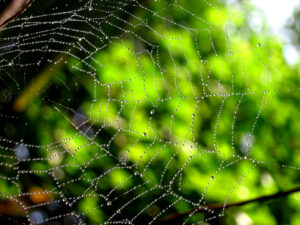Stories as light, web or glue.
Do you use stories or case studies as part of your communication process to engage or influence an audience?
If you do – and I hope that’s the case – you probably know that there’s a lot of information out there about the best ways to create and deliver one effectively.
So I want to keep today’s concept simple: it’s about using three specific lenses to categorise your stories. Doing this can help you to see them in new ways, and have more impact.
Note: these story categories relate to working across sectors to effect systems change, and are primarily targeted to nonprofits and NGOs – but I believe they can apply broadly, and be useful for you even if you’re not in that position.
Ella Saltmarshe is someone I’ve come across recently. An expert in narrative and systems change, she uses metaphors to describe three main qualities of story for us to consider when we want to have impact:
- Story as light
- Story as web
- Story as glue
Let me unpack them briefly: and even from the metaphors, you probably already have the key concepts!

It’s about illuminating paths for change through:
- Past failures and what we can learn from them.
- Current pioneers forging a new way that may not yet be common.
- An innovative future visionary story (or case study) of a community, company or individual client result you want to create.
A ‘current pioneer’ example could be you – or someone in the system – who’s developing a new way of using construction materials for sustainability. Or an educator trialling teaching principles that aren’t yet fully understood or acknowledged
For the future example, this is where “imagine…” or “what if…” works well. Feel-good future picture-painting. And this is important: wherever possible, we always want the audience to leave our interaction with a sense of possibility.
2. Story as web. This is about the web of narratives underpinning a challenge or current reality, and how to use story to reframe those narratives.
It’s also concerned with understanding our own ‘stories’ – the ones we tell ourselves about our own lives, and how they connect to other ‘players’ stories in the current context.
Story as web’s goal is to move people – who perhaps are stuck – to want to change. For this, you might think about issues that move from the personal or individual to broader group challenges and perspectives.
For example, a community garden project bringing together developers, residents, local businesses and nature.
Or a structural engineer bringing together different stakeholders to collaborate on new ideas for sustainable buildings.
Zooming in and zooming out, micro (personal) to macro (society) challenges. Where does the audience need to shift perspective? What can move them forwards most effectively?
3. Story as glue. For either connecting across divides and differences, or holding together partners (micro) organisations (meso) or whole communities (macro).

For lots of examples – in a long, brilliant article from Ella – go here.
Action step
When you think about these three different types of stories as light, web or glue:
Do any of them prompt you to think about using stories in a new way? Or using a story where you wouldn’t have considered one before?
Wishing you great speaking experiences!


Leave a Reply